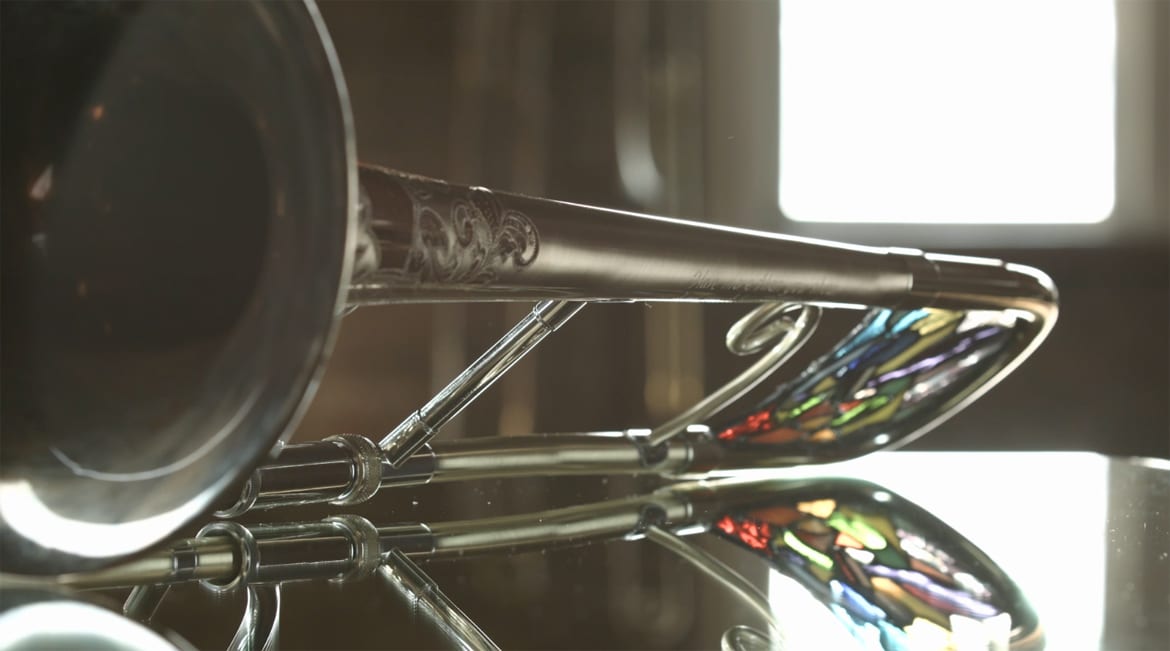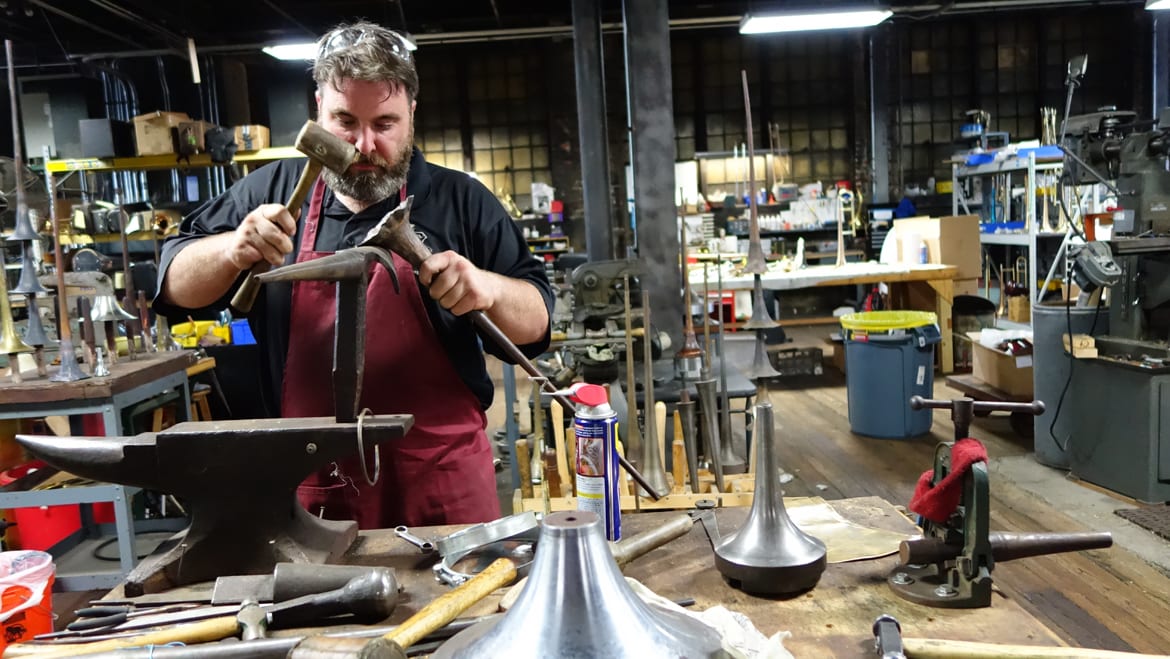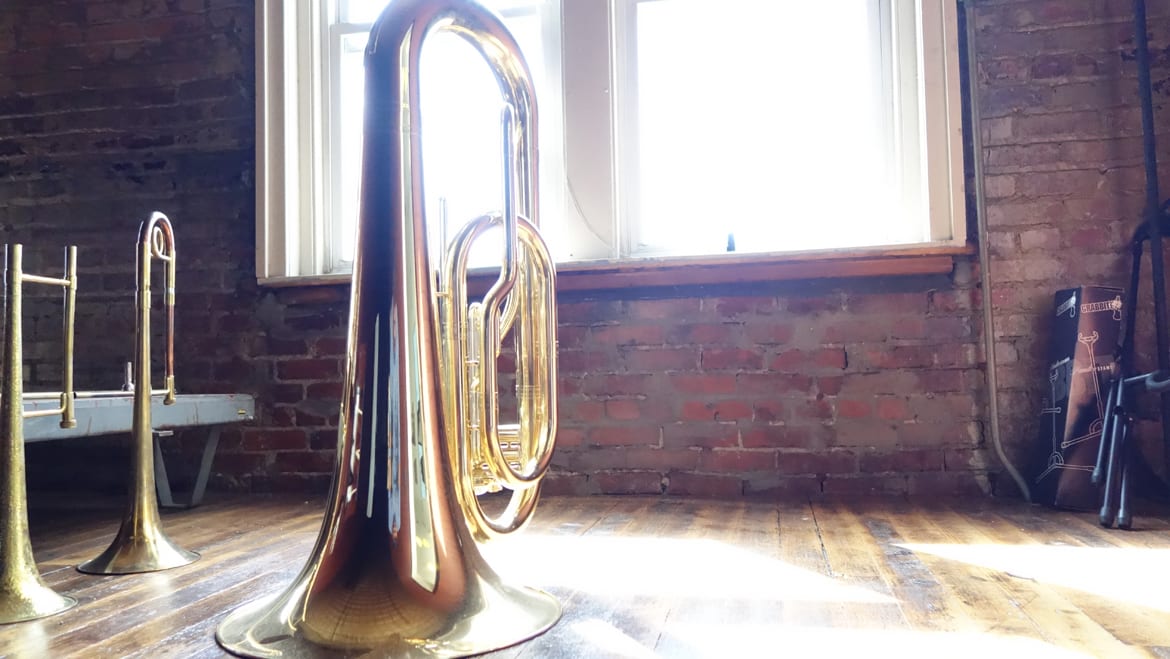Sympathetic Vibrations | Brass Knacks Local Horn-Maker Finds Success in Preserving Old Methods
 (Video: A production of the Sandbox Agency)
(Video: A production of the Sandbox Agency)
Published September 8th, 2016 at 2:59 PM
A chunk of jazz history is being preserved right off 12th St. and Vine. And that should seem confusing, considering the city razed much of the historic entertainment district in the ’60s and the official museum is a full six blocks south.
Nevertheless, on most days, on the second floor of a nearby warehouse, you’ll find Mike Corrigan, 36, lightly draped in sweat, pinballing amongst antique machinery, blow torches, and hammers as he deftly sculpts dingy-looking pipes and sheets of brass into some of the finest horns in the world.
The bulk of the dirty work for Corrigan’s company, Best American Craftsman, is done in a stiflingly hot workshop located at 1219 Lidia Ave. Huge fans ineffectively blow from every corner – their drone overpowered by the hard rock blaring over the shop speakers and the mechanical sounds of fabrication. Corrigan, also known as the “Horn Doctor,” smiles early and often during the tour of his shop. And he exudes a humble indifference about his astonishing ability to transform the unremarkable chunks of burnt metal hanging about the space into the pristine, mirror-shine instruments that will be their final form.
“We use a lot of various techniques that have been handed down over literally hundreds of years. And after a lot of work, we end up with a trumpet bell or trombone bell,” Corrigan said. “And we try to do as much of it as we can by hand.”
Corrigan’s path to this shop led him all over the country. He was born in England, but moved to the States as a child, spending most of his younger days in Maryland. He played in band in middle school and had a knack for learning to play, no matter the instrument.
He attended Red Wing Technical College in Minnesota – one of the few schools in the country that offered a degree in instrument repair. And one of his teachers at the college believed Corrigan had the right mix of skills to make horns, so he suggested that Corrigan seek employment at S.E. Shires, a Boston-based trombone maker. It was there that Corrigan apprenticed and learned the basics of horn making.
The love of a Kansas City woman drew him here, where he originally set up a repair shop out of his home in Overland Park in 2004. A few years later, after business had picked up, he bought shop space in Olathe.
But he wanted to be close to the action – and more importantly, the musicians – so he moved to his current downtown location in 2014. Corrigan admittedly knew little about the area of town that would be his new home. But when he learned about its history, he knew he had come to the right place.
For Corrigan, the past is an important element of his horn making. Many modern day, large-scale horn manufacturers use computer-based methods to do most or all of their machine work. Conversely, Corrigan’s process is a respectful — though time-consuming — nod to the industry titans of yesteryear.
“One thing that we’re doing here that’s very unique is we’re trying to preserve the way [horns] were made in the 1930s and ’40s,” Corrigan said. “They didn’t have computers making stuff back then. The guys that inspired me are guys like Domenick Calicchio and Earl Williams that were always a small shop, making instruments for people and executing a high level of craftsmanship.”
In the off chance you aren’t an instrument historian, Calicchio and Williams are widely regarded as the most legendary horn makers of all time. And their devotion to the craft has informed Corrigan’s methods. Corrigan even purchased antique machines used by the two legends, painstakingly restored them to functionality, and now uses them on a daily basis in his shop.
He also buys antique mandrels (cone-shaped pieces of steel that give horns their final, conical form) from legendary shops or those that were used to make respected horn designs. It can be a chore to find these rare tools, but Corrigan sees them as crucial to the type of instrument he wants to create.
“Just like anything else, everything was so much more well-made back in the day,” Corrigan said.
And Corrigan has fused these old methods with his own designs to create professional-grade horn lines that are raising eyebrows throughout the industry. If you look closely at the brass sections for Bruno Mars, Taylor Swift, Mark Ronson, Mumford & Sons, and Kool & the Gang, you’ll see those designs in the wild.
He has also made custom horns for renowned jazz and funk artists like Elliot Mason, Big Sam, Stafford Agee, and Delfeayo Marsalis. (Corrigan’s custom creation for Marsalis is detailed in the video above.)
And it’s there, in seeing his instruments used on stage, that Corrigan finds his drive to keep creating.
“For me, being able to take raw pieces of material and end up with a piece of equipment that somebody can use to express themselves with their music – that’s what does it for me,” Corrigan said. “I saw one of my horns being used during a Broadway show once. Until that moment, I hadn’t realized that I’m not just in the back making horns all day long, I’m actually a part of something much, much bigger.”
— Do you own a Corrigan horn? Seen one on stage? If so, share with us by commenting below, emailing pdancalderon@gmail.com, or tweeting us @dansascity.




